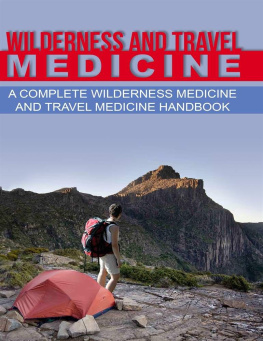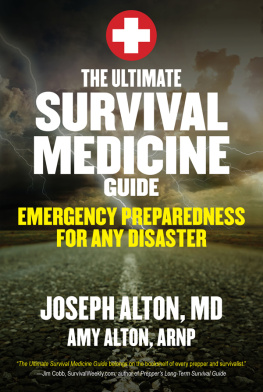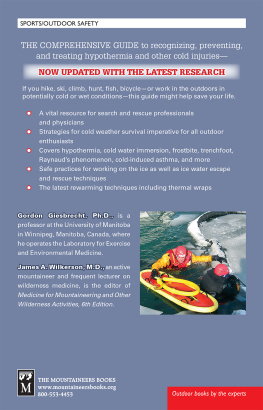WILDERNESS & TRAVEL MEDICINE
WILDERNESS & TRAVEL MEDICINE
A Comprehensive Guide
4th Edition
ADVENTURE MEDICAL KITS
Prepare for adventurous travel
Learn over 50 improvised techniques
Be safeand confident!
Eric A. Weiss, M.D., F.A.C.E.P.

This book is dedicated to Amy and Danny Weiss.
It is also dedicated to my mother and father,
for their steadfast and unselfish support
and unconditional love. 

THE MOUNTAINEERS BOOKS
is the nonprofit publishing arm of The Mountaineers,
an organization founded in 1906 and dedicated to the exploration,
preservation, and enjoyment of outdoor and wilderness areas.
1001 SW Klickitat Way, Suite 201, Seattle, WA 98134
2012 Adventure Medical Kits
All rights reserved
Fourth edition, 2012
No part of this book may be reproduced in any form, or by any electronic, mechanical, or other means, without permission in writing from the publisher.
Manufactured in the United States of America
Copy Editor: Heath Lynn Silberfeld/ enough said
Cover, Design, and Layout: Peggy Egerdahl
Illustrators: Gray Mouse Graphics, Moore Creative Designs, Rod Nickell,
Danny Sun, Butch Collier, and Patricia A. Jacobs
Cover photograph: Climbing El Pico de Orizaba in Mexico
Daniel H. Bailey/Corbis
Library of Congress Cataloging-in-Publication Data on file
ISBN (paperback): 978-1-59485-658-7
ISBN (e-book): 978-1-59485-659-4
CONTENTS
PREFACE
This book goes far beyond traditional first aid and empowers you to provide advanced care when you cant simply call 911. It combines more than twenty-five years of research, clinical experience, and teaching in a powerful guide for those who travel far from modern civilization. Revolutionary advances in emergency medicine knowledge, techniques, and equipment, as well as a new standard of first-aid practice, permeate the text and provide the foundation for laypeople to provide vital emergency care in remote settings.
This book is also unique in that it includes improvised techniques for treating specific injuries and illnesses. It provides creative solutions for fabricating bandages, splints, and even medication from whatever is at hand.
The information in these pages is intended to help you manage medical emergencies in remote environments when professional medical care or rescue is not readily available. It is not a substitute for taking a comprehensive first-aid or wilderness medicine course, or for seeking prompt medical care in the event of an illness or accident. Whenever someone becomes ill or injured, obtaining professional medical attention should take priority after administering appropriate first aid.
The reader should use this book for guidance in difficult and remote situations only and should not attempt to perform any procedure that he or she is not comfortable with or trained to render, unless the victim will die without that intervention. Legally, rescuers are always liable for their own actions and should never take any unnecessary risk or perform any medical procedure unless absolutely necessary.
Consult your physician concerning any medication that you carry, and inquire about potential complications or side effects. Make sure you are not allergic to any drugs that you may use. Sharing your medications with others is potentially dangerous and is not recommended.
Remember, the value of any first-aid book or medical kit is both enhanced and limited by the ability of the owner to use the information and contents effectively and creatively. Taking a Wilderness First Aid (WFA) course, Wilderness First Responder (WFR) course, Emergency Medical Technician (EMT) certification course, or Wilderness and Expedition Medicine Advanced Provider (WEMAP) courseand practicing your skills before you leave homewill better prepare you to manage an emergency when it occurs.
There are also other excellent wilderness medicine educational courses offered that will greatly enhance your knowledge and skill and prepare you for medical care in the backcountry or another austere environment. See www.wilderness-medicine.com
The author and publisher disclaim any liability for injuries, disability, or death that may result from the use of the information in this book, correct or otherwise, or the products in any Adventure Medical Kit.
May all of your journeys be safe, healthy, and filled with adventure!
Please use common sense. This book is not intended as a substitute for professional training or your own good judgment. It is incumbent upon any user of this guide to assess his or her own skills, experience, fitness, and equipment. Readers will recognize the inherent dangers in wilderness and marine activities and assume responsibility for their own actions and safety. The publisher and authors are not responsible for any adverse consequences resulting directly or indirectly from information contained in this book.
ACKNOWLEDGMENTS
It is with gratitude and appreciation that I acknowledge and thank my colleagues and friends who have shared my passion for wilderness medicine. Their experience, wisdom, and devotion to wilderness medicine are reflected in many parts of this book. In particular, I extend my gratitude and appreciation for their companionship, inspiration, and guidance to Howard Donner, M.D.; Lanny Johnson, FNP/PA; Peter Hackett, M.D.; Gene Allred, M.D.; Robert Norris, M.D.; Findlay Russell, M.D.; Joe Serra, M.D.; Henry Herrman, D.D.S.; Jim Bagian, M.D.; Tim Erickson, M.D.; Paul Auerbach, M.D.; Robert (Brownie) Schoene, M.D.; Karen Van Hoesen, M.D.; Luanne Freer, M.D.; Richard Clark, M.D.; Ken Zafren, M.D.; Bernard Dannenberg, M.D.; Gary Kibbee; Philip White; Sheryl Olson; and David Breashears.
Eric A. Weiss, M.D., F.A.C.E.P.
WILDERNESS AND TRAVEL MEDICINE
Diagnosis of an injury or illness relies on the ability of the rescuer to examine the victim thoroughly and identify signs and symptoms, which are important medical clues.
Signs and Symptoms
Signs are what you observe when you examine a victim with your eyes, ears, nose, and hands. For example, you might see bluish discoloration of the skin, hear labored or noisy breathing, smell pus in a wound infection, or feel swelling under the skin.
Symptoms are what the victim is experiencing, such as pain, nausea, dizziness, or headache.
In the wilderness, one must utilize whatever supplies or materials are on hand and depend heavily on common sense. Throughout the text you will find features entitled Weiss Advice, which describe improvised wilderness medicine techniques. Most of these recommendations are supported by research published in medical journals. However, some are merely anecdotal, based on my own personal experience and training.
Another common feature is the When to Worry boxes, which help the reader identify situations in which immediate evacuation from the wilderness is recommended. These are only general guidelines, however, and ultimately the circumstance, combined with your own resources, training, and experience, should dictate your actions. When in doubt, it is always better to get out and seek help rather than wait and see what happens.
Next page









